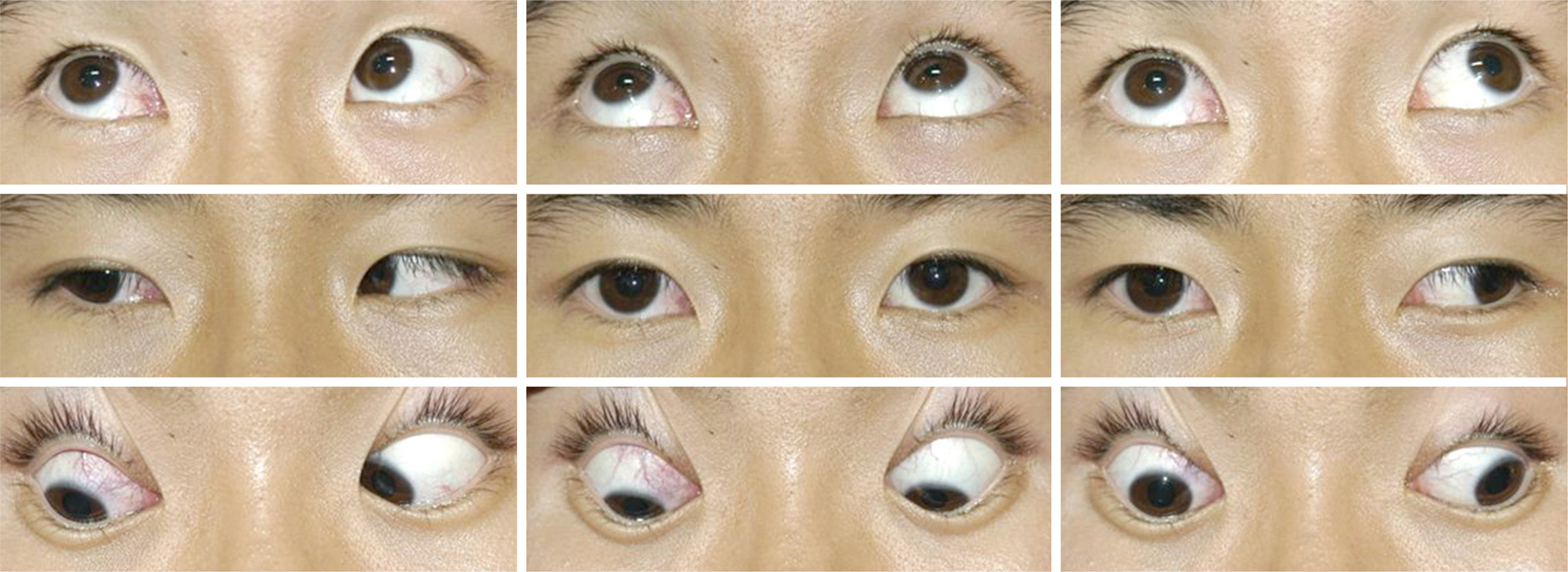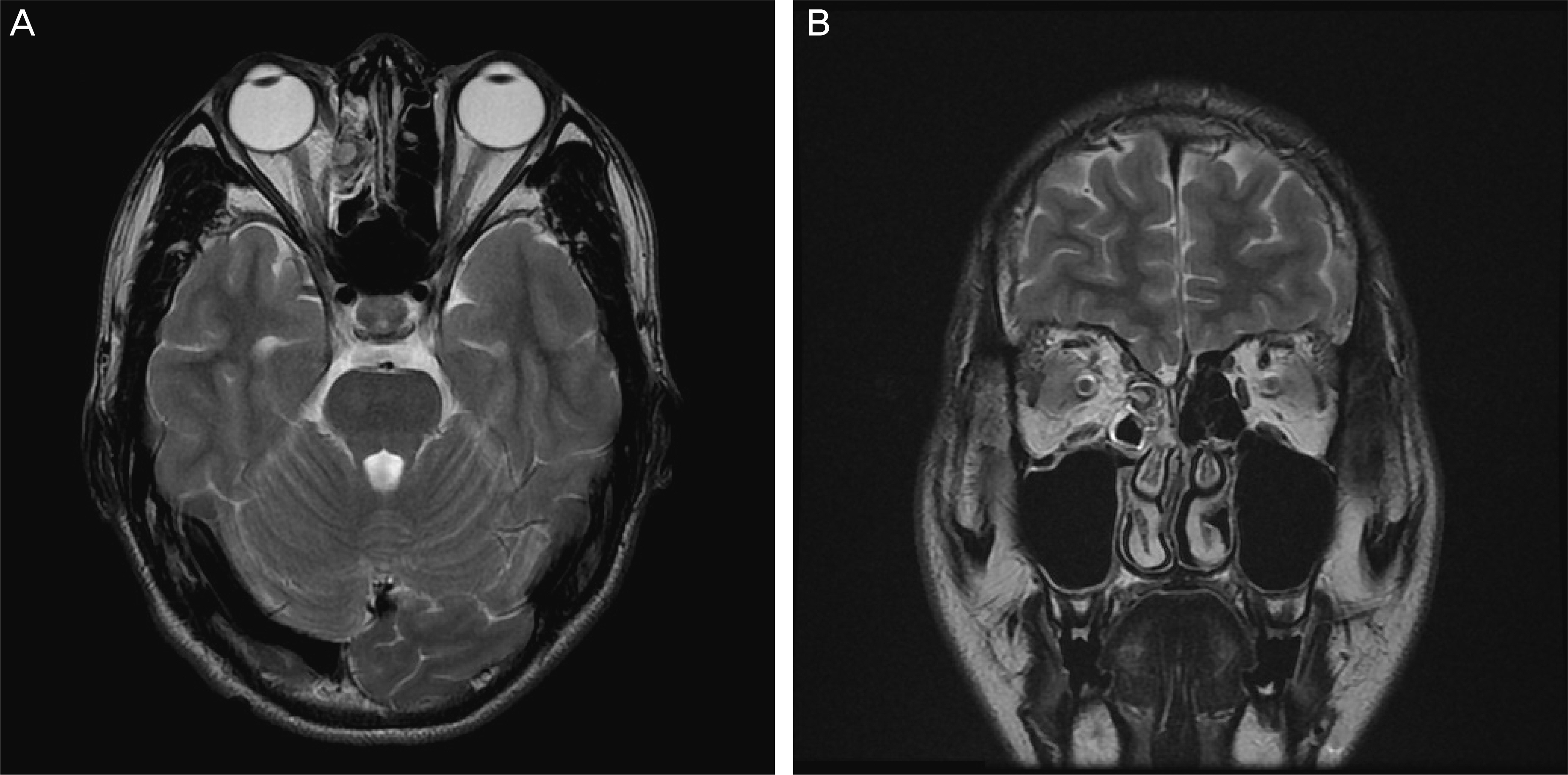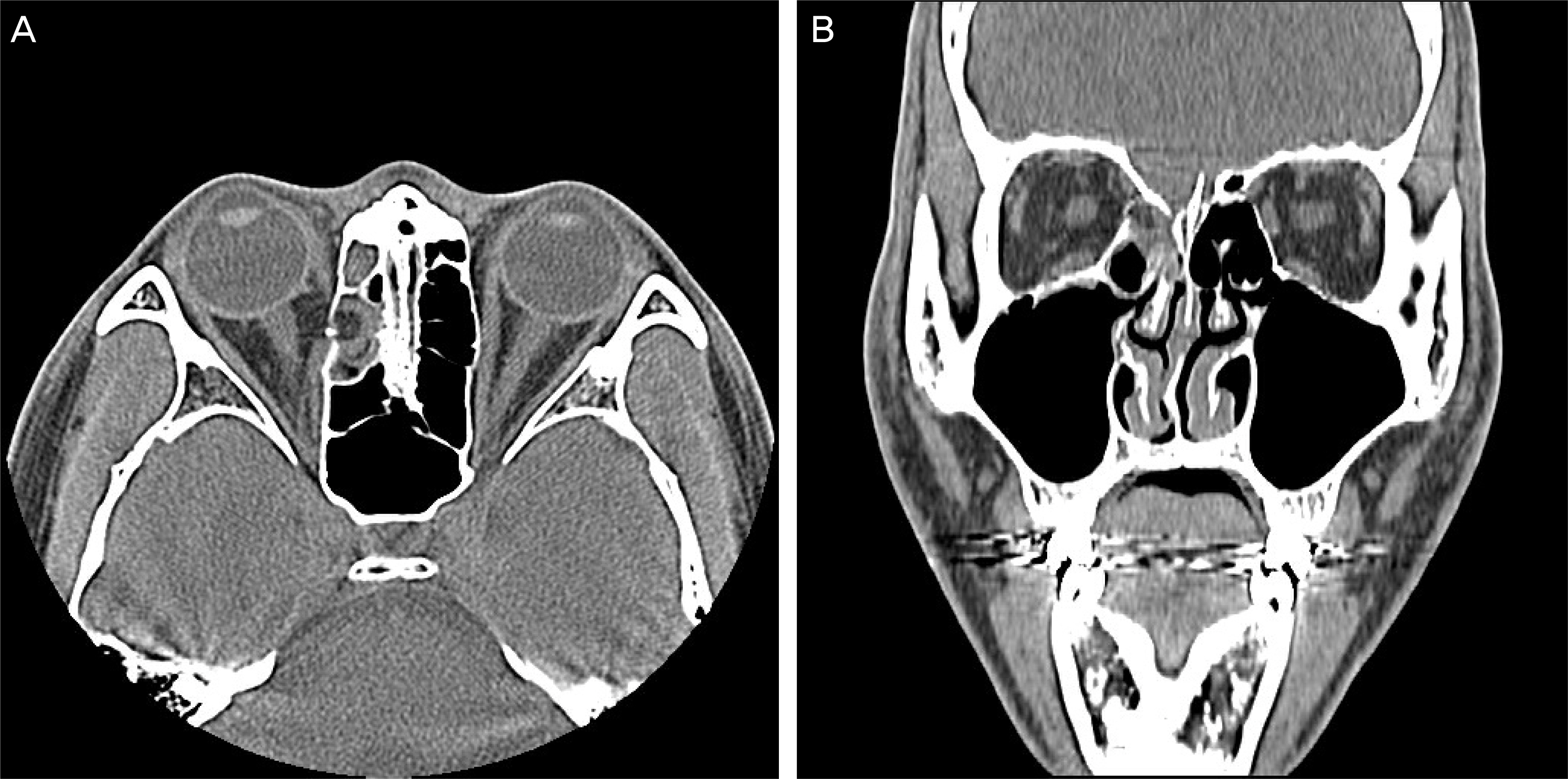J Korean Ophthalmol Soc.
2015 Jun;56(6):961-966. 10.3341/jkos.2015.56.6.961.
A Case of Pediatric Medial-Orbital Wall Fracture with Extraocular Muscle Entrapment
- Affiliations
-
- 1Department of Ophthalmology, Maryknoll Medical Center, Busan, Korea. pearlsj@hanmail.net
- KMID: 2339165
- DOI: http://doi.org/10.3341/jkos.2015.56.6.961
Abstract
- PURPOSE
To report a case of pediatric medial wall blowout fracture with entrapment of medial rectus muscle which can be easily misdiagnosed as a cerebral lesion.
CASE SUMMARY
A 16-year-old male visited our clinic with headache, severe restriction of his right eye movement, and diplopia after a head injury due to falling occurring 1 day before evaluation. The patient was inebriated at the time of the accident and could not recall the event but occipital hematoma was palpable. Periorbital ecchymosis or edema was not observed with minimal soft tissue injury except mild conjunctival injection on slit-lamp examination. The patient had an 18 prism diopter exodeviation at primary position and severe medial and mild lateral gaze limitation in his right eye. Brain magnetic resonance imaging (MRI) showed no specific cerebral findings although trapdoor orbital medial wall fracture with incarceration of soft tissue and medial rectus muscle at the medial wall fracture site of his right eye was observed. Within 48 hours from the first evaluation, the blowout fracture was repaired and 50 days postoperatively, right eye gaze limitation and diplopia were nearly recovered.
CONCLUSIONS
A case of pediatric blowout fracture with uncertain injury location, periocular ecchymosis, or edema absent could be misdiagnosed as a cerebral lesion. If a pediatric patient is experiencing gaze limitation, diplopia, nausea, or vomiting after trauma, neurological examination as well as evaluation for blowout fracture should be performed.
Keyword
MeSH Terms
Figure
Cited by 1 articles
-
Clinical Manifestations and Computed Tomography Findings of Trapdoor Type Medial Orbital Wall Blowout Fracture
Sung Ha Hwang, Su jin Park, Mijung Chi
J Korean Ophthalmol Soc. 2020;61(2):117-124. doi: 10.3341/jkos.2020.61.2.117.
Reference
-
References
1. Hoşal BM, Beatty RL. Diplopia and enophthalmos after surgical repair of blowout fracture. Orbit. 2002; 21:27–33.
Article2. Gilbard SM, Mafee MF, Lagouros PA, Langer BG. Orbital blowout fractures. The prognostic significance of computed tomography. Ophthalmology. 1985; 92:1523–8.
Article3. de Man K, Wijngaarde R, Hes J, de Jong PT. Influence of age on the management of blow-out fractures of the orbital floor. Int J Oral Maxillofac Surg. 1991; 20:330–6.
Article4. Koltai PJ, Amjad I, Meyer D, Feustel PJ. Orbital fractures in children. Arch Otolaryngol Head Neck Surg. 1995; 121:1375–9.
Article5. Jordan DR, Allen LH, White J, et al. Intervention within days for some orbital floor fractures: the white-eyed blowout. Ophthal Plast Reconstr Surg. 1998; 14:379–90.6. Anderson PJ, Poole MD. Orbital floor fractures in young children. J Craniomaxillofac Surg. 1995; 23:151–4.
Article7. Jurdy L, Malhotra R. White-eyed medial wall blowout fracture mimicking head injury due to persistent oculocardiac reflex. J Craniofac Surg. 2011; 22:1977–9.
Article8. Jank S, Schuchter B, Emshoff R, et al. Clinical signs of orbital wall fractures as a function of anatomic location. Oral Surg Oral Med Oral Pathol Oral Radiol Endod. 2003; 96:149–53.
Article9. Bansagi ZC, Meyer DR. Internal orbital fractures in the pediatric age group: characterization and management. Ophthalmology. 2000; 107:829–36.10. Brannan PA, Kersten RC, Kulwin DR. Isolated medial orbital wall fractures with medial rectus muscle incarceration. Ophthal Plast Reconstr Surg. 2006; 22:178–83.
Article11. Egbert JE, May K, Kersten RC, Kulwin DR. Pediatric orbital floor fracture: direct extraocular muscle involvement. Ophthalmology. 2000; 107:1875–9.12. Yang HW, Bae JH, Lee HC. The postoperative recovery of ocular motility in pediatric blow-out fracture. J Korean Ophthalmol Soc. 2003; 44:259–64.13. Thaller SR, Huang V. Midfacial fractures in the pediatric population. Ann Plast Surg. 1992; 29:348–52.
Article14. Park JH, Kim DH. Prognosis and clinical features of orbital wall fracture in preschool children. J Korean Ophthalmol Soc. 2011; 52:1490–5.
Article15. Klenk G, Kovacs A. Blow-out fracture of the orbital floor in early childhood. J Craniofac Surg. 2003; 14:666–71.
Article16. Cope MR, Moos KF, Speculand B. Does diplopia persist after blow-out fractures of the orbital floor in children? Br J Oral Maxillofac Surg. 1999; 37:46–51.
Article17. Waterhouse N, Lyne J, Urdang M, Garey L. An investigation into the mechanism of orbital blowout fractures. Br J Plast Surg. 1999; 52:607–12.
Article18. Manson PN. Pure orbital blowout fracture: new concepts and importance of the medial orbital blowout fracture. Plast Reconstr Surg. 1999; 104:878–82.
Article19. Gittinger JW Jr, Hughes JP, Suran EL. Medial orbital wall blow-out fracture producing an acquired retraction syndrome. J Clin Neuroophthalmol. 1986; 6:153–6.20. Duane TD, Schatz NJ, Caputo AR. Pseudo-Duane's retraction syndrome. Trans Am Ophthalmol Soc. 1976; 74:122–32.21. Ilankovan V, Hadley D, Moos K, el Attar A. A comparison of imaging techniques with surgical experience in orbital injuries. A prospective study. J Craniomaxillofac Surg. 1991; 19:348–52.22. Rumelt MB, Ernest JT. Isolated blowout fracture of the medial orbital wall with medial rectus muscle entrapment. Am J Ophthalmol. 1972; 73:451–3.
Article23. Kwon YH, Park DW, Chung JY, Ahn HB. A clinical study of pediatric orbital wall fracture. J Korean Ophthalmol Soc. 2006; 47:7–12.24. Mirsky RG, Saunders RA. A case of isolated medial wall fracture with medial rectus entrapment following seemingly trivial trauma. J Pediatr Ophthalmol Strabismus. 1979; 16:287–90.
Article25. Davidson TM, Olesen RM, Nahum AM. Medial orbital wall fracture with rectus entrapment. Arch Otolaryngol. 1975; 101:33–5.
Article26. Merle H, Gerard M, Raynaud M. Isolated medial orbital blow-out fracture with medial rectus entrapment. Acta Ophthalmol Scand. 1998; 76:378–9.
Article27. Segrest DR, Dortzbach RK. Medial orbital wall fractures: complications and management. Ophthal Plast Reconstr Surg. 1989; 5:75–80.28. Emery JM, Noorden GK, Sclernitzauer DA. Orbital floor fractures: long-term follow-up of cases with and without surgical repair. Trans Am Acad ophthalmol Otolaryngol. 1971; 75:802–12.29. Burnstine MA. Clinical recommendations for repair of isolated orbital floor fractures: an evidence-based analysis. Ophthalmology. 2002; 109:1207–10. discussion 1210-1; quiz 1212-3.30. Smith B, Regan WF Jr. Blow-out fracture of the orbit; mechanism and correction of internal orbital fracture. Am J Ophthalmol. 1957; 44:733–9.
- Full Text Links
- Actions
-
Cited
- CITED
-
- Close
- Share
- Similar articles
-
- Two Cases of Orbital Blowout Fractures with Extraocular Muscle Entrapment in Children
- The Direct Medial Canthal Approach in the Repair of Blowout Fracture of the Medial Orbital Wall
- The Effectiveness of MRI in Blow Out Fracture
- Endoscopic Intranasal Reconstruction of Medial Orbital Wall Fracture with Muco-periosteal Flap
- CT Findings of Orbital Blow-out Fracture





